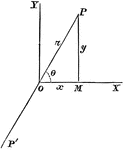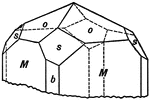
Scapolite
This figure shows a combination of forms sometimes observed on the silicate Scapolite, with the unit…

Calcium Phosphate, Apatite
This crystal of Calcium Phosphate, Apatite, represents a complex combination of hexagonal hemihedral…

Copper Silicate Showing Rhombohedral Tetartohedrism In the Hexagonal System
This is a crystal of Copper Silicate (Dioptase) with a rhombohedron of the third order, (s), in combination…
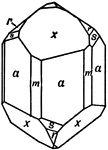
Phenacite
This crystal is mainly terminated by a rhombohedron of the third order, (x). With this form are associated…
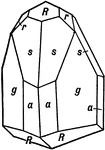
Tourmaline
This crystal of Tourmaline exhibits hemimorphism in the direction of the vertical axis. Its forms are…

Orthorhombic Crystal of Olivine
This is an orthorhombic crystal of olivine. It is formed by the orthorhombic prism in combination with…

Orthorhombic Crystal of Topaz
This form shows the fundamental prism (p) on a crystal of topaz, in combination with another prism,…
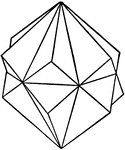
Twin Rhombohedrons
This figure shows two twin rhombohedrons, symmetrical with reference to a prism of the first order,…
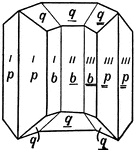
Cyclic Twinning
This crystal of Aragonite shows a method of twinning where the twinning plane may change its direction,…
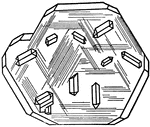
Rutile Growing Upon Titanic Iron
The tetragonal rutile grows upon the rhombohedral titanic iron, so that its prism of the second order,…
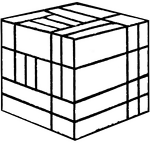
Froebel's Divided Cube (Complex)
This image shows one of Friedrich Froebel's divided cube (this one divided into many smaller cubes and…

Hargrave Kite
These Hargrave box kites are named so after their inventor, Lawrence Hargrave of Sydney. These kites…
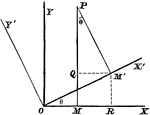
Rectangular Axes
Transforming from one set of rectangular axes to another with the same origin, but different direction.

Spectrometer
"An instrument used chiefly to measure the angular deviation of light rays in passing through a prism,…
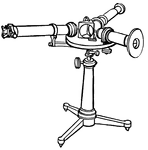
Prism Spectroscope from the Late 19th Century
"...a tube with a slit at the further end through which the light enters, and at the other end a collimating…

Direct Vision Spectroscope
"...an instrument which gives a spectrum when the source of the light is in a straight line with the…
Divider with Leaves and Sun Rays
This divider has leaves and small round kernels featured in a design on the sides. The center area has…
